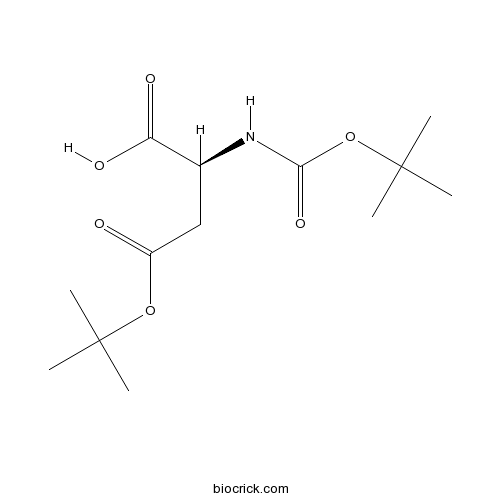Boc-Asp(OtBu)-OHCAS# 1676-90-0 |

Quality Control & MSDS
3D structure
Package In Stock
Number of papers citing our products

| Cas No. | 1676-90-0 | SDF | Download SDF |
| PubChem ID | 7010636 | Appearance | Powder |
| Formula | C13H23NO6 | M.Wt | 289.3 |
| Type of Compound | N/A | Storage | Desiccate at -20°C |
| Solubility | Soluble in Chloroform,Dichloromethane,Ethyl Acetate,DMSO,Acetone,etc. | ||
| Chemical Name | (2S)-4-[(2-methylpropan-2-yl)oxy]-2-[(2-methylpropan-2-yl)oxycarbonylamino]-4-oxobutanoic acid | ||
| SMILES | CC(C)(C)OC(=O)CC(C(=O)O)NC(=O)OC(C)(C)C | ||
| Standard InChIKey | PHJDCONJXLIIPW-QMMMGPOBSA-N | ||
| Standard InChI | InChI=1S/C13H23NO6/c1-12(2,3)19-9(15)7-8(10(16)17)14-11(18)20-13(4,5)6/h8H,7H2,1-6H3,(H,14,18)(H,16,17)/t8-/m0/s1 | ||
| General tips | For obtaining a higher solubility , please warm the tube at 37 ℃ and shake it in the ultrasonic bath for a while.Stock solution can be stored below -20℃ for several months. We recommend that you prepare and use the solution on the same day. However, if the test schedule requires, the stock solutions can be prepared in advance, and the stock solution must be sealed and stored below -20℃. In general, the stock solution can be kept for several months. Before use, we recommend that you leave the vial at room temperature for at least an hour before opening it. |
||
| About Packaging | 1. The packaging of the product may be reversed during transportation, cause the high purity compounds to adhere to the neck or cap of the vial.Take the vail out of its packaging and shake gently until the compounds fall to the bottom of the vial. 2. For liquid products, please centrifuge at 500xg to gather the liquid to the bottom of the vial. 3. Try to avoid loss or contamination during the experiment. |
||
| Shipping Condition | Packaging according to customer requirements(5mg, 10mg, 20mg and more). Ship via FedEx, DHL, UPS, EMS or other couriers with RT, or blue ice upon request. | ||

Boc-Asp(OtBu)-OH Dilution Calculator

Boc-Asp(OtBu)-OH Molarity Calculator
| 1 mg | 5 mg | 10 mg | 20 mg | 25 mg | |
| 1 mM | 3.4566 mL | 17.2831 mL | 34.5662 mL | 69.1324 mL | 86.4155 mL |
| 5 mM | 0.6913 mL | 3.4566 mL | 6.9132 mL | 13.8265 mL | 17.2831 mL |
| 10 mM | 0.3457 mL | 1.7283 mL | 3.4566 mL | 6.9132 mL | 8.6415 mL |
| 50 mM | 0.0691 mL | 0.3457 mL | 0.6913 mL | 1.3826 mL | 1.7283 mL |
| 100 mM | 0.0346 mL | 0.1728 mL | 0.3457 mL | 0.6913 mL | 0.8642 mL |
| * Note: If you are in the process of experiment, it's necessary to make the dilution ratios of the samples. The dilution data above is only for reference. Normally, it's can get a better solubility within lower of Concentrations. | |||||

Calcutta University

University of Minnesota

University of Maryland School of Medicine

University of Illinois at Chicago

The Ohio State University

University of Zurich

Harvard University

Colorado State University

Auburn University

Yale University

Worcester Polytechnic Institute

Washington State University

Stanford University

University of Leipzig

Universidade da Beira Interior

The Institute of Cancer Research

Heidelberg University

University of Amsterdam

University of Auckland

TsingHua University

The University of Michigan

Miami University

DRURY University

Jilin University

Fudan University

Wuhan University

Sun Yat-sen University

Universite de Paris

Deemed University

Auckland University

The University of Tokyo

Korea University
Boc-Asp(OtBu)-OH
- Z-Ser(tBu)-OH
Catalog No.:BCC2740
CAS No.:1676-75-1
- H-Glu(OBzl)-OH
Catalog No.:BCC2926
CAS No.:1676-73-9
- Benoxafos
Catalog No.:BCC5470
CAS No.:16759-59-4
- 11-Hydroxy-12-methoxyabietatriene
Catalog No.:BCN3253
CAS No.:16755-54-7
- PD-1/PD-L1 inhibitor 2
Catalog No.:BCC6520
CAS No.:1675203-84-5
- BADGE
Catalog No.:BCC7022
CAS No.:1675-54-3
- LY335979 (Zosuquidar 3HCL)
Catalog No.:BCC3878
CAS No.:167465-36-3
- Sophoracarpan B
Catalog No.:BCN6979
CAS No.:1674359-84-2
- Sophoracarpan A
Catalog No.:BCN6980
CAS No.:1674359-82-0
- H-Cys(Bzl)-OMe.HCl
Catalog No.:BCC2907
CAS No.:16741-80-3
- Fmoc-Lys(Mtt)-OH
Catalog No.:BCC3523
CAS No.:167393-62-6
- Zosuquidar
Catalog No.:BCC2074
CAS No.:167354-41-8
- RS 39604 hydrochloride
Catalog No.:BCC5694
CAS No.:167710-87-4
- Ornidazole
Catalog No.:BCC4815
CAS No.:16773-42-5
- 3-Epidehydrotumulosic acid
Catalog No.:BCN3649
CAS No.:167775-54-4
- PD98059
Catalog No.:BCC1098
CAS No.:167869-21-8
- Rubelloside B
Catalog No.:BCN1099
CAS No.:167875-39-0
- Wilforol A
Catalog No.:BCN3064
CAS No.:167882-66-8
- ent-Kaurane-16beta,19,20-triol
Catalog No.:BCN7654
CAS No.:167898-32-0
- 2,5-Bis(4-diethylaminophenyl)-1,3,4-oxadiazole
Catalog No.:BCC8502
CAS No.:1679-98-7
- Crassanine
Catalog No.:BCN4073
CAS No.:16790-92-4
- 19(S)-Hydroxyconopharyngine
Catalog No.:BCN3976
CAS No.:16790-93-5
- Taxachitriene A
Catalog No.:BCN6952
CAS No.:167906-74-3
- Taxachitriene B
Catalog No.:BCN6951
CAS No.:167906-75-4
Efficient Fmoc/solid-phase synthesis of Abu(P)-containing peptides using Fmoc-Abu(PO3Me2)-OH.[Pubmed:7822106]
Int J Pept Protein Res. 1994 Sep;44(3):288-94.
The synthesis of the two 4-phosphono-2-aminobutanoyl-containing peptides, Leu-Arg-Arg-Val-Abu(P)-Leu-Gly-OH.CF3CO2H and Ile-Val-Pro-Asn-Abu(P)-Val-Glu-Glu-OH.CF3CO2H was accomplished by the use of Fmoc-Abu(PO3Me2)-OH in Fmoc/solid-phase peptide synthesis. The protected phosphoamino acid, Fmoc-Abu(PO3Me2)-OH, was prepared from Boc-Asp-OtBu in seven steps, the formation of the C-P linkage being effected by the treatment of Boc-Asa-OtBu with dimethyl trimethylsilyl phosphite. Peptide synthesis was performed using Wang Resin as the polymer support with both peptides assembled by the use of PyBOP for the coupling of Fmoc amino acids and 20% piperidine for cleavage of the Fmoc group from the Fmoc-peptide after each coupling cycle. Cleavage of the peptide from the resin and peptide deprotection was accomplished by the treatment of the peptide-resin with 5% thioanisole/TFA followed by cleavage of the methyl phosphonate group by 1 M bromotrimethylsilane/1 M thioanisole in TFA.
Synthesis of the C-terminal half of thymosin alpha 1 by the polymeric reagent method.[Pubmed:6832888]
Int J Pept Protein Res. 1983 Feb;21(2):145-54.
In this report we further show the utility and efficiency of polymer-bound 1-hydroxybenzotriazole (PHBT) as an almost ideal support for the polymeric reagent method of peptide synthesis. This was demonstrated by the synthesis of thymosin alpha 1 (15-28), in which two suitably blocked segments, Boc-Asp (OtBu)-Leu-Lys (2Cz)-Glu (OBzl)-Lys (2Cz)-Lys (2Cz)-OH (3) and Boc-Glu (OBzl)-Val-Val-Glu (OBzl)-Glu (OBzl)-Ala-Glu (OBzl)-Asn-OBzl (2), were prepared entirely by utilizing PHBT activation for each coupling step. After appropriate deblocking of 2, segments 2 and 3 were coupled by the DCC-HOBT method, followed by complete deblocking and ion-exchange chromatographic purification, affording the C-terminal half of thymosin alpha 1, H-Asp-Leu-Lys-Glu-Lys-Lys-Glu-Val-Val-Glu-Glu-Ala-Glu-Asn-OH (1).


